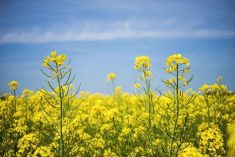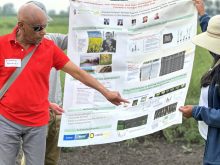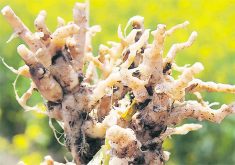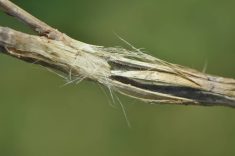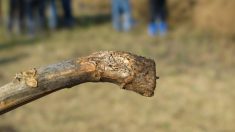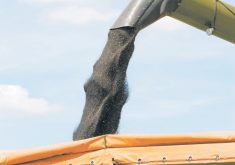Farmers preparing to seed canola might want to take a minute to visit the Canola Council of Canada’s website.
The national group, drawing on data from the 2022 Manitoba Canola Disease Survey, has summed up the most significant disease threats growers faced last year.
Posted through the council’s Canola Research Hub, the information also covers 2022 summaries from the rest of the Prairies and has links to scouting guides, digital planning tools, lab contacts for disease testing, production blog posts and climate maps.
Read Also

Manitoba boosts stake in cereals centre to $23.5 million
Premier Wab Kinew said the additional project funds will help ‘Trump-proof’ the provincial economy.
WHY IT MATTERS: Last year’s disease woes may impact how producers want to approach 2023.
Manitoba data shows that lodging, caused by high winds during canola’s bloom period last year, may have contributed to 2022 disease rates.
Both blackleg and sclerotinia stem rot were flagged for their spread in the province. Results from the 115 surveyed fields found blackleg in 85 per cent of them. Sclerotinia was found in 41 per cent. Incidence rates in the field were found at 13 and three per cent, respectively.

“Sclerotinia is a very destructive disease, in that it kills plants. It doesn’t just weaken them or reduce their seed production,” said Manitoba Agriculture plant pathologist David Kaminski.
“Resistance breeding for sclerotinia has been far less successful than resistance breeding for something like blackleg.”
While blackleg is also destructive, Kaminski said, most herbicide-tolerant crops today have been bred with blackleg resistance in mind.
“We cut through the stem to see how much blackleg is evident and what we’re generally seeing is the levels are quite low. The severity of blackleg has not been high even though the prevalence has been quite high.”
The 2022 survey rated both sclerotinia and blackleg severity as 1.2 on a five-point scale.
However, severity results for both diseases were calculated using the entire pool of surveyed crops, not just infected fields. Many more fields dodged sclerotinia completely compared to blackleg.
Eyes on verticillium stripe
Verticillium stripe remained the imminent concern. The soil-borne fungal disease was found in 38 per cent of surveyed fields. Within those, the disease had infected 23 per cent of plants.
Incidence rates for verticillium stripe were based only on infected fields, while incidence data for blackleg and sclerotinia was calculated using all surveyed crops.
The disease is a relative newcomer, first confirmed in Western Canada in 2014. Because of that short history, it’s also a disease with significant gaps in agronomic knowledge.

What Kaminski does know, however, is that the percentage of fields reporting the fungus is rising.
“We have seen that the crop is more likely to lodge when the stem is weakened by verticillium and, with these pod-shatter-resistant varieties that are left to stand longer, you might have parts of the crop lying down,” Kaminski said.
“That makes it difficult, if not impossible, to harvest. You might be leaving a lot of the yield behind in the field.”
Clubroot is also monitored, said Kaminski, “however, it’s been very rare that we have found it in one of those fields. Clubroot-infected fields are usually brought to our attention by agronomists or farmers themselves.”
Joining the team
Growers might consider volunteering their fields for this year’s survey.
“We always like to have co-operators, especially new co-operators who haven’t been involved before,” Kaminski said.
Manitoba’s canola survey began in 1971 and has been used to track the spread and severity of a number of diseases. The data contributes to agronomy, management and future breeding priorities.
Kaminski and his crew like to survey 100 to 150 fields each year. Sampling was historically later in the season when crop was mature and ready for swathing. With the rise of shatter-resistant varieties and straight cutting, however, they’re using a different maturity indicator.
“We use the seed colour change in the lower pods,” Kaminski said. “The crop is done flowering; it’s produced most of its seed and the ones in the lower pods are starting to get some colour in the seed coat.”
After arranging a time to visit the farm, Kaminski’s team heads into the field beyond the headlands, where there’s a possibility of double seeding and accidental extra fertilizer, so they can get a representative sample of the crop.
“We pull 20 plants at five different sites using a ‘W’ pattern to pace off those sites,” he said. “You’ll end up some distance from where you started, but you’ll have a bundle of canola plants from each of those sites, and then we determine how much blackleg is there, how much sclerotinia there might be, and now we’re beginning to look at verticillium stripe.”
Canola pathogens are highly adaptable, making continued surveys even more important.
There are also immediate agronomic benefits for those who volunteer their fields to be surveyed.
“They do get information back,” Kaminski said. “It’s after the fact, but you can plan for subsequent years. If you saw a lot of blackleg, you would try to be much more conservative with your rotation or look for a variety that had better resistance to the races of the pathogen that you’ve got in your soil.”
Farmers who would like to participate in disease surveys may contact Kaminski at 204-750-4248.



